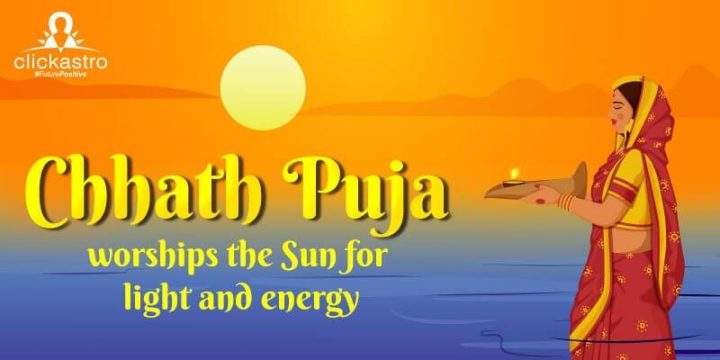Chhath Puja comes after Diwali and is widely celebrated in northern India, especially in parts of UP and Bihar. Chhath means six. Chhath Puja is the puja that is performed on the sixth day after Diwali.
The 2024 Chhath Puja happens on November 7
- Sunrise on Chhath Puja Day – 6:39 AM
- Sunset on Chhath Puja Day – 5:41 PM
- Shasthi Tithi begins: November 07, 12:41 AM
- Shasthi Tithi ends: November 08, 12:35 AM
Chhath Puja is more accurately a four-day celebration starting on the second day after
Amavasya till the sixth day after Amavasya. The Amavasya of Kartik month, which is Diwali, is viewed as the darkest night in the
Hindu calendar.Two days later, the Moon starts getting visible again. The return of the light. The celebration that begins on this day, peaks on Panchami, or the fifth day, and concludes on the morning of the sixth day. This is the Chhath Puja festival. Since it is the Sun who is the source of light on Earth, the Sun god is worshipped during this Puja.
Deity of worship
The Sun or Surya Deva is worshipped during Chhath Puja. The worship reflects the importance given to light in Vedic science. The Amavasya or the New Moon day during the month of Karthik is considered the darkest of the year. Darkness invites negative energy. To dispel such negative energies, diyas are lit as part of Diwali celebrations during Kartik Amavasi. Two days later, the crescent of the Moon will appear in the sky. This appearance of the Moon heralds the arrival of light to prevent Earth from going completely dark. But, the Moon does not by itself give out light. The Moon reflects the light of the Sun since it is the Sun that is the primary source of light. The astrologers of ancient Bharath knew this. Hence, Chhath Puja is dedicated to the Sun.
Chhath Puja mantras
Mantras are hymns designed to unlock powers hidden deep in the subconscious mind through repeated uttering. There are different mantras meant to invoke a certain Devi or Deva. For mantras to bring effect, the utmost discipline of the body and mind is necessary. Each day on the Earth brings with it certain forces that are unique to the cosmic alignment of that day. Chanting certain mantras on a specific day brings specific results. It can bring significant positive changes to the life of the person.
Chhath Puja sees the worship of Surya Deva. Chanting mantras related to Surya Deva improves the quality of Surya or the Sun in the horoscope of a person. If the person is suffering from some kind of Surya Dosha, the effects can be mitigated by chanting the following mantras during the days of the Chhath Puja.
While performing Chhath Puja, chant these names of the Sun:
Om Mitraya Namah: Om Raway Namah: Om Surya Namah: Om Bhanve Namah: Om Khagay Namah: Om Ghrini Surya Namah: Om Pushne Namah: Hiranyagarbhaya Namah: Marichaye Namah: Adityaya Namah: Savitre Namah: Arkay Namah: Bhaskarai Namah: Sri Savitri Suryanarayanaya Namah:
Suryadev mantra (Chhath Puja Surya mantra)
Adidev Namastubhyam Prasidam Bhaskar, Divakar Namastubhyam Prabhakar Namostute.
Arghya Mantra (Chhath Puja Surya Arghya mantra)
Oh aihi Suryadev Sahasransho Tejo Rashi Jagatpatte, Om Surya Namah, Om Adityaya Namah, Om Namo Bhaskarai Namah. Arghya Samarpayami.
Chhath Puja rituals
The Chhath Puja is a four-day event. It starts on the second day after Amavasya. That is when the crescent of the Moon appears. With each passing day, the Moon grows larger, till the day of Panchmi, or the fifth day, which is considered the most auspicious. On the morning of the sixth day or the Shashti day, the Chhath Puja concludes.
On the first day, devotees take a bath in the holy river and then eat sattvic food. This is called ‘Nahaay and Khay’, which means bath and food. The house and surroundings are cleaned and made tidy. The second day is for Lohanda Kharna, which means fasting. Devotees spend the entire day fasting without even drinking a drop of water. In the evening sugarless kheer, puri, and bananas are used to break the fast.
The third day is the day of Panchami where devotees observe the Sandhya Arghya or the offering at dusk. On this evening, the devotees get themselves to the banks of the holy river and pay their respects facing the setting Sun. The fourth or the final day of the Chhath Puja, which is Shashti day, sees the devotees observe Usha Arghya. Here the devotee wakes up early in the morning, goes to the river bank, and pays his respects to the rising Sun. After this, breakfast is eaten thus putting an end to the Chhath Puja.
Chhath Puja stories
Chhath Puja is mentioned in both Ramayana and Mahabharata. In Ramayana, it is said that Devi Sita observed Chhath Puja to ensure prosperous days ahead after their return to Ayodhya. Lord Rama was put into exile for fourteen years by his stepmother Kaikeyi. This period ended with Lord Rama defeating Ravana and gaining Devi Sita back.
After this, Lord Rama chose Amavasya of the Kartik month to return to Ayodhya. After reaching Ayodhya, Lord Rama wished to put his 14 years of sacrifice firmly in the past and start anew. Lord Rama is a descendant of the Surya Vansha. For her husband’s sake, Devi Sita observed a fast on the day of Panchami and ended it by worshipping the Surya Deva in the evening. This practice then evolved to become the Chhath Puja that is observed in modern-day India.
In Mahabharata, it is believed Devi Kunti conceived Karna as a result of her regular observing of the Chhath Puja. It is also mentioned that Draupadi, the wife of the Pandavas observed Chhath Puja for the health and welfare of her husbands.
Significance of Chhath Puja.
Chhath Puja is the celebration of light as the core of all existence. The Shashti that comes after Kartika Amavasya is the best time to celebrate the gift of light. This is corroborated by modern science as well. The sixth tithi of the Kartik Shukla Paksha is seen as a unique astronomical event. The Sun is in the southern hemisphere during this time. The rays of the Sun have more UV content in them. Worshipping the Sun or the Surya Deva in the evening and the morning is a good way to negate such effects of the Sun.
Chhath Puja is beneficial in getting rid of toxins from the body. It also destroys bacteria and prepares the body for the winter months ahead. Observing Chhath Puja protects children from diseases and problems and grants them good health and long life.

